When cool weather approaches, you may begin to ponder the most efficient way to upgrade your existing antennas or add to your current capabilities.
And when it comes to amateur radio antennas, you won’t find a better place to start your search than DX Engineering.com, where you’ll discover a huge selection of top amateur radio antenna brands and accessories, including today’s spotlight innovators: InnovAntennas.
Exclusively Sold in North America by DX Engineering
Back in the summer of 2021, WiMo of Herxeim, Germany, on behalf of InnovAntennas Limited UK, selected DX Engineering as the sole North American distributor of the range of antenna products by InnovAntennas. WiMo, one of Europe’s leading ham radio manufacturers and retailers, has been producing InnovAntennas as an OEM for more than five years.
This partnership has benefited discerning ham radio operators who have seen extraordinary results from InnovAntennas’ finely engineered, extensively tested, and robustly constructed products. These include the DXR Series Multiband HF Beams, featuring short booms (10.2 to 12 feet) with full-size elements or capacity-loaded shortened elements; High HF Band Optimized Log Periodic Arrays; Heavy-Duty HF+6M Yagi; 10M and 6M Yagis; and other options.
Today, OnAllBands is excited to highlight some of the latest additions to InnovAntennas’ already impressive lineup.
50-LFA-4-LN 4-Element 50 MHz Yagi
Here’s a great opportunity to be ready for the 6M “Magic Band” bonanza whenever it rolls around.
Specifically designed for noisy city environments, this loop-fed, low-profile antenna is optimized for front-to-back performance on a relatively short boom of 11.15 feet. The results: rejection of as much local noise as possible and more signals heard. The 50-LFA-4-LN offers excellent forward gain of 9.4 dBi (14.9 dBi at 10M above ground), an exceptional 32 dB front-to-back rating, and SWR less than 1.4:1 across 50-50.5 MHz.
The antenna includes a center mount boom that accommodates mast clamps for up to two-inch masts. It provides a sleek 1.77-square-foot wind load, making this beam ideal for typical 6M stations.

LFA-WOS 6M 7-Element Yagi
This antenna was specially designed by G3WOS for hams who are looking for the perfect 6M antenna for use with a freestanding mast.
Boasting good gain characteristics and a particularly long boom for excellent front-to-back ratio, the mid-sized LFA-WOS is a great choice for EME and weak-signal DXing. Featuring an average gain of 12.9 dBi, it delivers suppressed lobes in both azimuth and elevation plots, making it ideal for noisy city installations. Its maximum transmit power is 5 kW with SWR less than 1.1:1 in the 50-50.45 MHz range.
For enhanced performance, both the last third of both the reflector and first director elements are bent toward the driver loop. The antenna comes with marine-grade stainless steel fittings, original Stauff insulation clamps, and mill-finished boom and elements for high accuracy.
OP-DES 50 MHz Yagi Antennas
OP-DES stands for Opposing Phase Driven Element System. This means the ends of the dipole radiator of these antennas is angled backwards toward the reflector, parallel to the boom. This results in opposing phase relationships in the ends of the driven element, providing a clean directional pattern with few side lobes. Users can expect optimized gain over a wide frequency range, while retaining a good front-to-back ratio.
The driven element dipole of an OP-DES antenna has a low impedance of 50 ohms. This eliminates the need for matching elements or a transformer balun. For this reason, the antenna is offered without a balun, but an RF choke balun made of ferrites on coax should be used at the feedpoint terminal studs. With the coaxial cable directly connected to the driven element dipole, well over full legal limit power levels are possible.
The InnovAntennas OP-DES 50 MHz Yagis are designed through careful numerical optimizations to provide excellent gain with good bandwidth. As a result, a low SWR of 1.1:1 is achieved in the frequency range of 50-50.6 MHz for the OP-DES 50 MHz Yagi six-element model (below) or 50-51.35 MHz for the five-element model.

LFA3-HG 50 MHz 5-Element Yagi
This model was designed to deliver the best gain on a relatively short boom. It offers forward gain of 10.7 dBi (16.2 dBi at 10M above ground) and an exceptional 31 dB front-to-back rating with SWR less than 1.4:1 in the 50-50.4 MHz range. The low-profile LFA3 achieves a significant reduction of noise, allowing clear reception of much weaker signals. The introduction of the loop-shaped and phase-fed dipole delivers considerably fewer side lobes in the Yagi directional pattern.
With less energy absorbed from the sides and from behind, the antenna becomes quieter and achieves a higher forward gain.

VertiGO HF Vertical Antennas
Last year, DX Engineering began carrying three models of InnovAntennas VertiGO HF Vertical Antennas. They come with a base-mounted remote tuner for DX and domestic operation:
- IVA-18484-0122: Tunable for 40-15M, 33 Feet (below)
- IVA-18484-0123: Tunable for 60-17M, 43 Feet
- IVA-18484-0124: Tunable for 80-17M, 66 Feet


Find the complete lineup of InnovAntennas antennas at DXEngineering.com.

